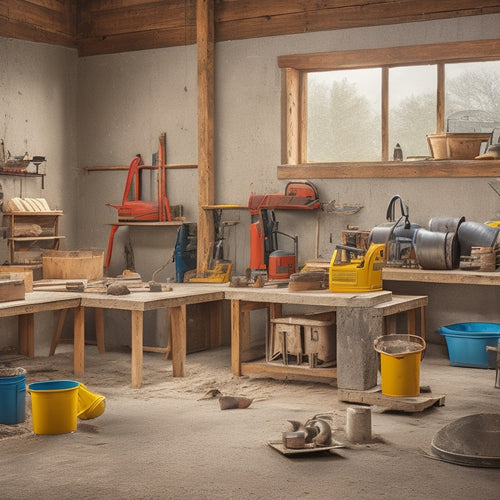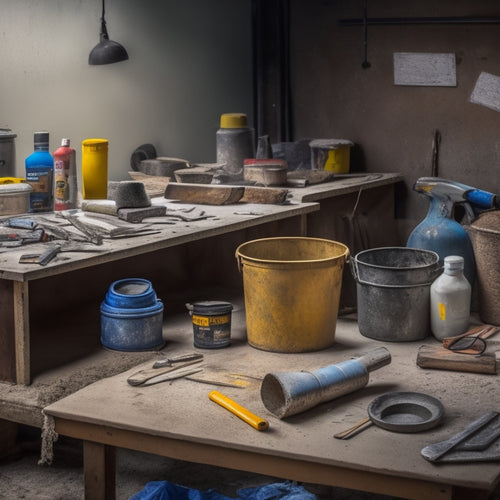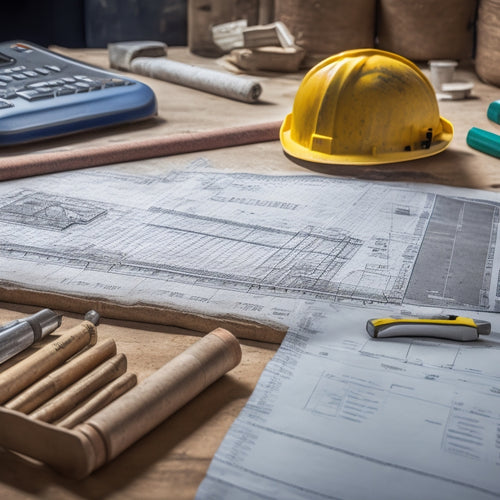
Top Tools for Concrete Laying Professionals
Share
You'll need a range of tools to guarantee precise preparation, placement, and finishing of concrete blocks. Start with essential hand tools like trowels, alignment tools, and impact tools. Then, consider power tools like concrete mixers, power trowels, and edging capabilities to accelerate installation while maintaining quality. Don't forget measuring and leveling equipment, such as laser levels, measuring tapes, and digital levels, which guarantee accurate measurements and alignment. Finally, prioritize safety gear and specialized tools for finish work, like power trowels, edgers, and jointers. By investing in these top tools, you'll take your concrete laying skills to the next level – and discover the full range of possibilities.
Key Takeaways
• A pointing trowel, finishing trowel, and notched trowel are essential hand tools for precise mortar application and adhesive placement.
• Power tools like concrete mixers and power trowels accelerate installation while maintaining quality, reducing labor fatigue and enhancing efficiency.
• Measuring and leveling equipment, including laser levels and digital levels, ensure accurate alignment and leveling in concrete laying projects.
• Personal protective equipment (PPE) such as hard hats, safety glasses, and respiratory protection are crucial for preventing injuries and health issues.
• Specialized tools like power trowels, edgers, and jointers are necessary for achieving high-gloss finishes and decorative edges in concrete finish work.
Essential Hand Tools for Block Laying
You'll regularly reach for a set of essential hand tools when laying concrete blocks, as they enable you to efficiently prepare, place, and finish each block with precision. Among these tools, a range of trowel types is vital for achieving a smooth, even finish.
You'll need a pointing trowel for applying and smoothing mortar, a finishing trowel for creating a fine finish, and a notched trowel for applying adhesive to the block surface.
To guarantee accurate block alignment, you'll also need a spirit level and a string line. These tools allow you to check the block's position and make adjustments as needed, assuring a straight and level course.
A rubber mallet is also essential for tapping blocks into place without damaging them. Additionally, a jointer or tamping tool helps to compact the mortar and remove excess material.
Power Tools for Efficient Installation
By incorporating power tools into your concrete laying workflow, you can markedly accelerate the installation process while maintaining precision and quality.
One essential power tool for efficient concrete mixing is the concrete mixer. These machines can handle large quantities of concrete, guaranteeing consistent mixes and reducing labor fatigue. Look for mixers with adjustable speed controls and robust mixing blades to achieve the perfect blend.
For finishing and smoothing concrete surfaces, power trowels are a game-changer. These tools allow you to achieve a high-gloss finish quickly and efficiently, reducing the need for manual labor. Opt for power trowels with variable speed controls and adjustable handle heights to promote maximum comfort and control.
Additionally, consider investing in power trowels with built-in edging capabilities to streamline the finishing process.
Measuring and Leveling Equipment
Accurate measurements and precise leveling are critical to achieving a successful concrete lay, and a range of specialized tools are essential for guaranteeing that your pours are perfectly aligned and level. You'll want to invest in top-quality measuring and leveling equipment to assure precision and accuracy.
| Tool | Description |
|---|---|
| Laser Levels | Guarantee accurate leveling and alignment with high-precision laser levels that project a level line or dot onto the surface. |
| Measuring Tapes | Durable, fiberglass-reinforced measuring tapes provide precise measurements and are resistant to wear and tear. |
| Digital Levels | Advanced digital levels offer precise angle and slope measurements, making it easy to identify and correct deviations. |
| Transit Levels | High-accuracy transit levels allow for precise leveling and alignment, ideal for large-scale concrete projects. |
When selecting measuring and leveling equipment, consider factors such as accuracy, durability, and ease of use. Look for tools with advanced features, such as Bluetooth connectivity and smartphone app integration, to streamline your workflow and improve efficiency. By investing in the right tools, you'll be able to guarantee precise measurements and leveling, resulting in a successful concrete lay that meets your high standards.
Safety Gear for Concrete Handling
With precise measurements and leveling guaranteed, it's now time to focus on protecting yourself from the hazards associated with concrete handling, which demands an extensive range of safety gear to prevent injuries and guarantee a safe working environment.
As a concrete laying professional, you're well aware of the risks involved, and that's why personal protective equipment (PPE) is essential.
Here are the must-haves for your safety arsenal:
-
Hard hats and safety glasses: Prevent head and eye injuries from falling objects or debris.
-
Respiratory protection: Filter out dust, silica, and other airborne particles that can cause respiratory issues.
-
Steel-toed boots and gloves: Protect your feet and hands from heavy objects, cuts, and abrasions.
- High-visibility vests: Increase hazard awareness and visibility on the job site, especially in low-light conditions.
Specialized Tools for Finish Work
You'll rely on a range of specialized tools to achieve a smooth, even finish, free of imperfections and defects that can compromise the structural integrity and aesthetic appeal of your concrete project.
For instance, you'll need a power trowel or a ride-on trowel to apply smoothing techniques and achieve a high-gloss finish. These tools allow for precise control and can cover large areas quickly. Additionally, you'll require a variety of edgers and jointers to create clean, defined edges and joints that complement your decorative finishes.
Other essential tools include float blades, which help to remove excess material and create a smooth surface, and finishing blades, which are designed for specific finishing techniques such as broom finishing or stamping.
Don't forget about the importance of specialized hand tools, like tamping tools and joint rakes, which are used to fine-tune your finish and add subtle textures.
Frequently Asked Questions
How Often Should I Clean and Maintain My Concrete Laying Tools?
You should clean and maintain your concrete laying tools regularly to extend their tool lifespan.
Develop a habit of cleaning your tools after each use to prevent cement and concrete residue buildup.
Implement effective cleaning techniques, such as wire brushing and solvent cleaning, to remove stubborn stains.
Can I Use Regular Gloves Instead of Specialized Safety Gloves?
When it comes to hand protection, you can't skimp on quality. Regular gloves won't cut it on a concrete laying site.
The glove material matters - specialized safety gloves are designed to withstand harsh chemicals, abrasion, and heavy impact. They provide superior grip, flexibility, and dexterity, ensuring you can work efficiently while keeping your hands safe from injuries.
Don't risk it, invest in gloves that meet industry standards for ideal hand protection.
Are There Any Specific Certifications Required for Concrete Laying Professionals?
When you're considering a career in concrete laying, you'll want to know about certification requirements.
In this field, you'll need to meet industry standards, which often involve obtaining specialized certifications.
You'll typically require OSHA certification, and depending on your location, additional certifications like ACI or PCI may be necessary.
These certifications guarantee you're knowledgeable about safety protocols and best practices, giving you a competitive edge in the industry.
What Is the Average Cost of Starting a Concrete Laying Business?
When starting a concrete laying business, you'll need to conduct a thorough cost analysis to determine the business startup costs. This includes expenses like equipment, materials, labor, and marketing.
On average, the initial investment can range from $10,000 to $50,000 or more, depending on the scope of your operations. You'll need to factor in costs like concrete mixers, trowels, and other essential tools, as well as licenses, insurance, and employee salaries.
A detailed cost analysis will help you plan and budget effectively for a successful business startup.
How Do I Handle and Store Leftover Concrete After a Project?
When wrapping up a project, you're left with the dilemma of handling and storing leftover concrete.
It's crucial to adopt sustainable concrete recycling methods to reduce waste and minimize environmental impact.
For leftover concrete storage, consider using sealed containers or specialized bags to prevent contamination and hardening.
Properly label and date the stored concrete, and keep it in a dry, protected area to guarantee it remains usable for future projects.
Conclusion
You've got the skills, and now you've got the tools. With these top tools for concrete laying professionals, you're ready to take on any project that comes your way.
Did you know that the concrete industry is projected to reach $443.4 billion by 2025? With the right tools and expertise, you'll be contributing to that growth in no time.
Stay ahead of the curve and keep building – the world needs more of what you do.
Related Posts
-

What Tools to Rent for a Concrete Home Reno
When tackling a concrete home renovation, you'll need to rent a variety of specialized tools to get the job done. For...
-

3 Best Tools to Buy for Concrete Repair Online
When buying tools for concrete repair online, you'll want to research multiple retailer options to find the best prod...
-

5 Tips for Accurate Concrete Measurement Tools
To guarantee accurate concrete measurement, you'll want to calibrate your measuring tools regularly, choosing a frequ...


